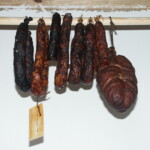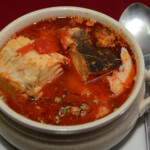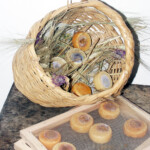The flavours, pleasures and art of entertaining of our lands
Santiago do Cacém, a mountainous region stretching from the plain to the sea, offers gastronomic diversity where rich flavours endure in history and tradition.
Gastronomy represents a true symbiosis of diverse heritages.
Ancestral tastes with remote origins, flavours of an interior Alentejo that contrast with the fragrances of a unique coastline, where the lagoon embraces the sea.
Our flavours of the earth and the sea offer a perfect combination of ingredients, aromas and colours that call for informal get-togethers, seeking the truly traditional.
The quality of the eels from our Lagoon is unquestionable, due mainly to the annual opening of the lagoon to the sea. Traditional ensopado and caldeirada stews are made from this delicacy, which can be eaten at the restaurants on the Costa de Santo André coast. Also, fried eels are a very popular snack, which may be accompanied by local bread and wine.
The açorda, which in Arabic means “bread soup”, is made with slices of wheat bread and is a very popular delicacy prepared in many restaurants throughout the county. The most sought-after are coriander açorda, pennyroyal açorda, cod açorda, purslane soup and hare soup.
With the tomato, a fruit with a high vitamin C content and antioxidant and diuretic properties, tomato soup and tomato jam is prepared, with Alvalade being the most prominent region for these delicacies.
The Alentejo gaspacho is a very refreshing dish, prepared with water, ice, crushed garlic, salt, olive oil, vinegar, oregano, tomato, cucumber, peppers and bread in small bites. It is served with fried fish or small strips of ham.
The dish migas differs from the açorda in that the bread, instead of being sliced, is transformed into a thin pudding fried in pork fat, resulting in the famous “Migas à Alentejana”, served with pork and slices of orange.
Pork, pork offcuts and lamb are the meats most widely used to make these dishes.
Pork, one of the staples of our diet, can be found in multiple culinary creations, almost always prepared with red pepper seasoning and preserved in its own butter. Among the most popular dishes, fried pork, roast pork loin, pork à Alentejana, brains with pork, pork chops, stew à Portuguesa and chick pea stew can be found on the menus of almost all the restaurants in the county of Santiago do Cacém.
Sausages such as linguiça (smoke cured pork sausage seasoned with garlic and paprika), chouriço (smoke cured pork sausage seasoned with wine, paprika, garlic, and salt) and farinheira (smoked sausage made from wheat flour, pork fat and seasonings) are sold and in many cases made on the premises by the butchers themselves, along with torresmos (pork rind), with which the traditional bolo dos torresmos cake is prepared, with pork lard being used as seasoning in the preparation of many dishes.
Lamb stew, oven-roasted lamb and roasted lamb’s head are true delicacies.
Game meats such as hare, rabbit, partridge and wild boar are extensively used in a wide range of dishes and snacks.
Coriander, pennyroyal, oregano, mint, pepper, parsley and bay leaf are the aromatic seasonings most widely used in the confection of our delicacies.
The wines bottled in the county of Santiago do Cacém are the whites, reds and rosés from the Adega do Cebolal winery, in Vale das Éguas. The wines from the small wineries in Santa Cruz and Santo André can be purchased as of December.
Depending on the taste of each person, cheeses may be plain or coated in salt or paprika.
In the county of Santiago do Cacém, beekeeping is common in all parishes, with lavender honey being the best known product.
In terms of confectionery, best known are the Alcomonias, a traditional, lozenge-shaped sweet of Arab origin, prepared with a dough made from toasted flour, pine nuts and honey.
Made in a similar manner, “rebuçados” made from pine nuts and honey come wrapped in colourful papers.
The bolo de Santiago cake, made with almond, black seed squash, cinnamon and sugar, is one of the delicious desserts that appear on the menus of some restaurants.
Also notable are the “argolinha” fritters, the “filhó” doughnuts and “popias caiadas” biscuits from Alvalade, bread dough cake and, linked to the festivities of the popular saints, the alconcoras (dry cake made from honey and cinnamon) and cachamorras (dry cake made from walnuts and cinnamon).
The manufacture of liqueurs is an activity that is lost in the mists of time and forms an integral part of our gastronomic and cultural heritage.
Essentially prepared by female hands, our tasty liqueurs made from pennyroyal and from myrtle berries or blueberries are a real delight, having antioxidant and medicinal properties.
Fine delicacies, good drink and good company are the ingredients that help us to engrave unique places and unique moments in our memories forever!





















